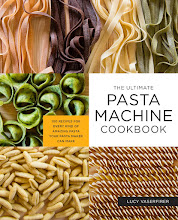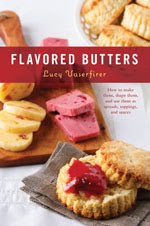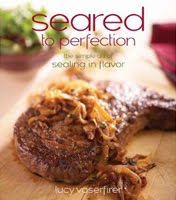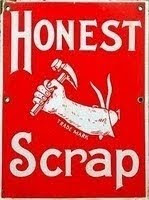Clockwise from top right: garganelli, corzetti, farfalle, spaghetti, linguini, pappardelle.

But before I share the recipe, I'd like to invite you to tune in to my interview on the Lonely Gourmet at 6PM EST on Friday, October 14. Click to listen live.
Fresh Egg Pasta
Printable Recipe
13 ounces all-purpose flour, plus more for dusting
4 large eggs, at room temperature
Combine the flour and eggs in a large bowl and mix until a rough dough forms. The dough will seem dry at this point, but resist the temptation to add more liquid. Transfer to a work surface and knead for 10 to 15 minutes, or until smooth and elastic. Wrap in plastic wrap and let rest for about half an hour.
Cut the dough into sixths. Flatten 1 portion of dough and pass it through a pasta machine 3 times with the rollers at the widest setting, folding the pasta sheet widthwise into thirds between each pass and feeding the folded pasta into the machine with the folds perpendicular to the rollers. Pass the remaining portions of dough through the pasta machine in the same manner. Close the rollers down 1 notch and pass each pasta sheet through the pasta machine once. Continue passing the pasta sheets through the pasta machine with the rollers at successively narrower settings until the pasta sheets are the desired thickness. As you work, lay the pasta sheets flat in a single layer on a lightly floured surface or clean kitchen towels.
Cut and form the pasta sheets as desired into lasagna, pappardelle, tagliatelle, fettuccini, linguini, spaghetti, garganelli, corzetti, farfalle, ravioli, tortellini, or other shape.
Makes about 1 ¼ pounds, enough for 4 to 6 main-course servings. Making pasta is all about developing a feel for the dough—the more batches you have under your belt, the easier it becomes. Here's what you need to know to get started…Farm fresh eggs with golden yolks make for the best pasta. The amount of flour needed may vary depending on the brand of the flour, the size of the eggs, and the humidity. It's much easier to add flour to a wet dough than it is to add liquid to a dry dough, so hold back a bit of the flour at first and then add more if the dough feels sticky. The result should be a firm dough that isn't sticky at all, and kneading it is quite a workout. If you or the dough need a break, wrap the dough in plastic wrap or cover with an inverted bowl and let rest for up to 5 minutes. When you just can't knead any more, take heart in the fact that rolling the dough through the pasta machine will continue the kneading process. Keep pieces of dough covered until you're ready to roll them out. Using a pasta machine is easier with an extra set of hands, so bribe someone to do the cranking for you with a fabulous homemade pasta dinner. Lightly flour the pasta sheets if they stick or tear as they go through the pasta machine. Catch the pasta sheets as they come out from between the rollers without pulling or tugging. Sheets of pasta may stick to smooth surfaces such as marble or stainless steel, so keep work surfaces dusted with flour or lay the pasta sheets on clean flour sack kitchen towels. Pasta is less likely to stick to wood surfaces. If the pasta sheets get too long to work with comfortably, feel free to cut them into more manageable lengths. For most shapes, pasta is rolled as thin as the second-to-last or third-to-last narrowest setting of the rollers, but thickness is largely a matter of personal preference. Passing all of the pieces of pasta through each setting of the rollers is more efficient than sheeting 1 piece at a time, and it allows all of the sheets to dry at a more even rate. However, hand-formed shapes such as garganelli, farfalle, ravioli, and tortellini must be made with freshly-rolled pasta that hasn't had a chance to dry and harden, so sheet and form just 1 or 2 pieces of dough at a time. For long cut pasta such as fettuccini and spaghetti, allow sheets of pasta to dry a bit until they just start to feel leathery before cutting them. Strands of pasta cut from sheets that are too moist will stick to each other, and pasta sheets that are too dry will shatter when cut. Dust pasta sheets with flour if there's ever any sign of stickage, but try not to use any more flour than necessary (excess flour can be removed with a pastry brush). To cut sheeted pasta into ribbons or strands, dust it with flour and pass it through pasta machine cutters or fold it up widthwise loosely and slice it lengthwise with a knife. For other shapes, use a straight or fluted pastry wheel or other specialized tool. Cut and form shapes as follows:
Lasagna: Cut the sheeted pasta into 9-inch lengths.
Pappardelle: Cut the sheeted pasta into ½ to 1-inch wide strands.
Tagliatelle: Cut the sheeted pasta into ¼ to ½-inch wide strands.
Fettuccini: Cut the sheeted pasta into ¼-inch wide strands.
Linguini: Cut the sheeted pasta into 1/8-inch wide strands.
Spaghetti: Cut the sheeted pasta into strands that are as wide as they are thick.
Garganelli: Cut the sheeted pasta into 1 ½ to 2-inch squares. Roll each pasta square, starting from a corner, around a rolling stick while pressing lightly against a garganelli board, forming ridged tubes with pointed ends. A gnocchi board may be used if a garganelli board is unavailable.
Corzetti: Cut the sheeted pasta into circles using a corzetti cutter and press each circle, first making sure that it is well floured, using a corzetti stamp, forming large coins.
Farfalle: Cut the sheeted pasta into 1×2-inch rectangles and pinch each rectangle at the center, forming butterflies or bows.
Ravioli: Cut the sheeted pasta into pieces slightly longer than a ravioli plaque. Dust a pasta sheet with flour on 1 side only and lay it floured side down on the ravioli plaque. Place a small amount of filling into each depression. Using a fingertip, lightly moisten the pasta around each depression with water. Drape another sheet of pasta over the filled ravioli plaque, eliminating any air pockets as you go. Roll a rolling pin across the ravioli plaque, pressing down hard to cut out the ravioli. To remove the ravioli, invert the plaque onto a lightly floured surface. Make more ravioli with the remaining pasta pieces in the same manner. If a ravioli plaque is unavailable, sandwich evenly spaced bits of filling between sheets of pasta in the same manner, moistening the pasta around the filling with water and eliminating air pockets, and cut ravioli using a cookie cutter, ravioli stamp, or pastry wheel. Size varies.
Tortellini: Cut the sheeted pasta into circles using a cookie cutter or ravioli stamp. Place a small amount of filling in the center of a pasta circle. Using a fingertip, lightly moisten the edges of the circle with water. Fold the wrapper in half over the filling, forming a half circle, and eliminating any air pockets, firmly pinch the edges together to seal. Lightly moisten the corners of the wrapper along the straight side of the half circle with water. Fold the two corners together and firmly pinch to seal. Make more tortellini with the remaining pasta circles in the same manner. Sheeted pasta may be cut into squares using a pastry wheel instead of circles. Formed in the same manner as the wontons pictured here. Size varies.
Maltagliati: Scraps leftover from cutting other pasta shapes, literally "badly cut". Good for soup.
Arrange short cut pasta in a single layer and dust long cut pasta generously with flour and form loose nests on pasta screens, lightly floured parchment-lined baking trays, or towel-lined baking trays. Alternatively, hang long cut pasta on a pasta rack. Pasta may be left at room temperature like this to dry for up to several hours or cooked immediately. Cook in a large pot of boiling, salted water until al dente. Cooking time is usually only 2 to 5 minutes, depending on the thickness of the pasta and how long it has been left to dry.












12 comments:
I love making pasta, it's such a relaxing exercise! And I like your flour-egg ratio, in my opinion perfect! I do grams but that's the same - for every 100g one egg.
;D
Homemade pasta is my absolute favorite food to make. However, I don't yet have a pasta machine, so it makes for quite the tiring exercise, rolling and stretching endlessly by hand! It also doesn't make for very fancy shapes, but it's delicious nonetheless:)
OH MY! nothing better than freshly made pasta!!!!! that's a bunch of beautiful shapes you've made! i've only gone as far as linguini, spaghetti, tortellini and fettucini. and the occasional ravioli that i make. I am envious of your headmast photo of kitchen equipments!
Appeal: Now I understand why cooking sometimes referred to as Culinary Art. This is Art!
Taste: What can be better than pasta? Egg pasta, of course!
Thank you.
I tried this recipe at home tonight. Your pointers at the Clark College class last week really helped fix the problems I was having! No more lace comes out of my pasta maker! Just beautiful sheets. Thank you!
Would it be possible to store the pasta long term? And if so, any way to store it other than freezing? Any help you could give on this would be greatly appreciated. :)
Michael W,
If you let the pasta dry completely, you can store it in a tightly sealed container in the pantry. But personally, I’m not sure why you’d want to do that. Doesn’t long term storage sort of defy the point of fresh pasta?
Oh, I love fresh pasta. However, I hate buying store bought pre-made pasta due to additives. Thus, if I could have some homemade "pre-made" pasta to just quickly throw a meal together, I'll be plenty happy. If I have time to make fresh pasta for a meal? Then I'll gladly do so. But sometimes... you just don't have the time for it.
Thank you for responding so promptly, and I really do appreciate it.
Hi Lucy,
What a wonderful lesson. I think that many of these shapes, especially corzetti, are really like edible art. Plus it is so muich fun to make them.
It is a pleasure to make your online acquaintance and see your beautiful work. I am so glad that Pamela Sheldon Johns told me about you.
I made your four egg pasta today and it is so easy to make and turned out perfect. I used my Bosch mixer for most of the kneading which really simplified the process. Now the only thing left is to enjoy eating the pasta. Thank you for this great recipe.
Rachel
I just made your pasta recipe again and it turns out perfect every time. I love this recipe.
I just made your egg pasta again and it turned out perfect. It is such an easy recipe especially because the flour is perfectly measured with a scale so there is no guessing. Thank you simplifying making pasta.
Post a Comment